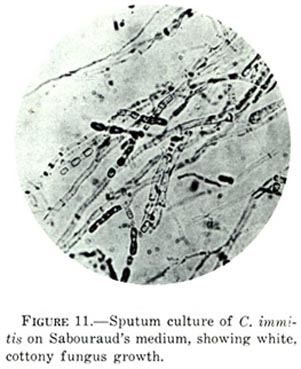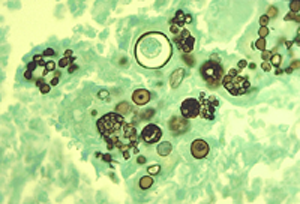Coccidioides immitis: Difference between revisions
| Line 50: | Line 50: | ||
==Application to Biotechnology== | ==Application to Biotechnology== | ||
Antigen 2 (Ag2), a major immunoreactive component of Coccidioides immitis mycelium- and spherule-phase cell walls, was recently cloned was shown to elicit T-cell responses in Coccidioides- immune mice (20). The production of a recombinant peptide that expresses C. immitis-specific Ag2 epitopes provides a useful reagent for examining the role of anti-Ag2 antibodies in coccidioidomycosis. | |||
Coccidioides posadasii Δchs5 is a strain that is excluded from the select agent list. Sixteen assays using test reagents from three different ACCUPROBE Coccidioides immitis culture identification test lots had an average of 132,998 relative light units (RLU), which is well beyond the 50,000-RLU positive cutoff value for the test. Coccidioides posadasii Δchs5 is a satisfactory quality control isolates in the ACCUPROBE culture identification test for Coccidioides immitis. (21) | |||
==Current Research== | ==Current Research== | ||
Revision as of 04:20, 29 August 2007
A Microbial Biorealm page on the genus Coccidioides immitis
Classification
Higher order taxa(1)
cellular organisms; Eukaryota; Fungi/Metazoa group; Fungi; Dikarya; Ascomycota; Pezizomycotina; Eurotiomycetes; Eurotiomycetidae; Onygenales; mitosporic Onygenales; Coccidioides
Species
|
NCBI: Taxonomy |
Coccidioides immitis
Description and significance
Coccidioides immitis is a dimorphic fungus (existing in two distinct forms) with a unique life cycle. In the soil, the organism exists as a mold with septated hyphae resembling a shape of a barrel. When entering a host, the arthroconidia (spores) break off from the hyphae and evolve into round structures called spherules. Then when inside the host, spherules grows and undergo internal division, forming smaller structures called endospores. Large spherules can rupture to release packets of endospores, resulting in new foci of infection within the host (2). Coccidioides immitis main habitat is in soil, geographically limited to California's San Joaquin valley region, and in the desert southwest and Mexico, where it co exists with its closest relative, Coccidioides posadasii.
Formal description of C. immitis was performed by Rixford and Gilchrist from a case observed in California in 1986 (3). However, the parasite was then still thought to be a protozoan. The correct taxonomic status of C. immitis as an ascomycete fungus was demonstrated by Ophuls and Moffit in 1900 (4) by culture on artificial of the fungal mycelia using arthrospores isolated from laboratory infections of guinea pigs. It is important to have its genome sequences because Coccidioides immitis, along with its relative Coccidioides posadasii, can cause a disease called Coccidioidomycosis (Valley Fever), and it is a rare cause of meningitis, mostly in immunocompromised persons, and the disease can be fatal. Persons afflicted with HIV/AIDS are highly susceptible to Coccidioidomycosis and suffer a high mortality rate from the disease. (5).
Genome structure
The current total unique contig length of Coccidioides immitis genome is 28,876,843 bp (base pairs); the estimated genome size is 29 Mb. Also, Coccidioides immitis strain RS was sequenced by way of sequencing each end of plasmids and Fosmids from libraries containing randomly sheared fragments of 4 kb, 10 kb, and 40 kb average size respectively. Coccidioides immitis strains contain either a MAT1-1 or a MAT1-2 idiomorph, which is 8.1 or 9 kb in length, respectively, the longest reported for any ascomycete species. MAT1-1 and MAT1-2 contain four or five genes, respectively, more than are present in the MAT loci of most ascomycetes. Along with their cDNA structures, all genes in the MAT loci are transcribed (6). An analysis of 436 Coccidioides isolates from patients and the environment indicates that in both Coccidioides immitis and C. posadasii, there is a 1:1 distribution of MAT loci, as would be expected for sexually reproducing species. The current assembly contains 50 sequence contigs in 7 supercontigs (scaffolds).(7)
Coccidioides immitis SOWgp gene was also isolated; SOWgp encodes an immunodominant, spherule outer wall glycoprotein that is presented as a component of a parasitic phase-specific, membranous layer at the cell surface. SOGwgp translates a 422-amino-acid (aa) polypeptide that contains 6 copies of a 41- to 47-residue tandem repeat enriched in proline (20.4 mol%) and aspartate (19.7%). Two additional isolates of C. immitis produce SOWgps of different molecular sizes (328 and 375 aa) and show a corresponding difference in the number of tandem repeats (four and five, respectively)(8). The recombinant polypeptide (rSOWp) was shown to bind to mammalian extracellular matrix (ECM) proteins in an in vitro assay, suggesting that the parasitic cell surface antigen may function as an adhesion. Deletion of the SOWgp gene by using a targeted gene replacement strategy resulted in partial loss of the ability of intact spherules to bind to ECM proteins and a significant reduction in virulence of the mutant strain. The parasitic cell surface glycoprotein encoded by the SOWgp gene appears to function as an adhesion and contributes to the virulence of C. immitis.(8)
Cell structure and metabolism
Cells of Coccidioides immitis in the hyphal stage have thin, structure-less walls and a cytoplasmic membrane. Many nuclei, elongated mitochondria with both transverse and longitudinal cristae, and lipid particles are present. A large central accumulation of electron transparent polysaccharide appears in the spherule as the cell grows. The peripheral cytoplasm contains nuclei, each enclosed in a double-layered membrane, mitochondria, and small dense particles. Prior to cleavage the polysaccharide droplets are lost, while mitochondria become small and spherical. Endospores are formed and liberated when the spherule wall breaks. These begin to grow and repeat the cleavage cycle. (11)
Cell wall: Like most pathogenic fungi, the cell wall is rich in chitin and chitin metabolism is a reasonable target for the design of antifungal agents. The antigenic composition of an alkali-soluble, water-soluble cell wall extract of Coccidioides immitis is heterogeneous in composition, containing two distinct antigenic components. One is present as a polymer that is antigenically identical to a polymeric antigen in coccidioidin, designated antigen 2. The other component presented an unusual precipitin pattern in that a cathodal leg was demonstrable in the absence of an anodal leg (9). As stated before, the fungal cell wall is a vital and complex structure containing chitins, along with mannoproteins and glucans. Any disruption in its integrity should affect growth. The cell wall provides a unique therapeutic opportunity for antifungal agents by targeting a structure not found in mammalian cells. The echinocandins are cyclic hexapeptides, members of a new class of antifungal agents. They appear to inhibit the synthesis of 1, 3-β-d-glucan, a major cell wall component which provides structural integrity and osmotic stability in most pathogenic fungi (10).
Metabolism: Of various carbohydrates and amino acids tested, glucose, mannose, fructose, and glutamate were the most efficient substrates metabolized by the endospores and spherules of Coccidioides immitis (12). Strain M-11 of Coccidioides immitis was found to utilize mannitol for growth in the mycelial form but not in the spherule form. Cell-free extracts of both forms, grown on glucose, were capable of reducing nicotinamide adenine dinucleotide with mannitol-1-PO but not with mannitol. The extracts accomplished a rapid oxidation of reduced nicotinamide adenine dinucleotide by fructose-6-PO, the expected product of mannitol-1-PO oxidation. (13)
Ecology
The distribution of Coccidioides immitis has been shown to be restricted to America through ecological and epidemiological studies. Coccidioides immitis has been known for its saprophytic nature, tolerance for high soil salinity in climates of high temperature and low rainfall (14). Epidemiological studies and case reports have extended the apparent range of this organism; however, almost all soil isolates in Arizona and California have been from areas with the physical and biotic parameters of this zone. The repeated isolation of C. immitis from the soil has been from small, well defined areas; (14) .C. immitis has been observed to grow in the soil if naturally infected soil is simply enriched with sterile water. The ease with which it can be grown is paradoxical to its naturally restricted distribution to soils in endemic areas (15). Animals, although not the major natural reservoir, cannot be ignored as possible factors in the ecology of C. immitis.
Pathology
Coccidioides immitis possess branching septate hyphae that are 2 to 4 m in diameter (18) and allow them to develop infectious arthroconidia along its length. Such structure is the most major virulent factor for Coccidioides immitis. As the arthroconidia mature, they become spores that are easily airborne and can be carried long distances by the wind. It takes only a few inhaled arthroconidia to produce infection in the host. When inhaled, the arthroconidia is small enough (<10 m) (18) to escape upper respiratory defenses to lodge in the lungs where it transforms into a multinucleated spherule rather than a yeast. Using internal division, the spherule produces hundreds of uninucleated endospores. The spherule ruptures on maturity releasing the endospores, which in turn matures to from new spherules. (18)
The initial host immune response is a transient polymorphonuclear leukocyte response directed at arthroconidia. As spherules develop, the inflammatory response becomes mononuclear and persists throughout the course of the infection. The primary lung infection is asymptomatic in 60% of individuals. The other 40% develop a mild to moderate influenza-like syndrome 1 to 3 weeks (19) after exposure that includes cough, fever, night sweats, pleuritic chest pains, arthralgias, myalgias, fatigue, and anorexia. Chest radiographs often show lung infiltrates and perihilar adenopathy with occasional pleural effusions. Most pulmonary infections are cleared by the immune system with symptoms resolving in 2 to 3 weeks (19) or occasionally longer if the individual is immunosuppressed.
Application to Biotechnology
Antigen 2 (Ag2), a major immunoreactive component of Coccidioides immitis mycelium- and spherule-phase cell walls, was recently cloned was shown to elicit T-cell responses in Coccidioides- immune mice (20). The production of a recombinant peptide that expresses C. immitis-specific Ag2 epitopes provides a useful reagent for examining the role of anti-Ag2 antibodies in coccidioidomycosis.
Coccidioides posadasii Δchs5 is a strain that is excluded from the select agent list. Sixteen assays using test reagents from three different ACCUPROBE Coccidioides immitis culture identification test lots had an average of 132,998 relative light units (RLU), which is well beyond the 50,000-RLU positive cutoff value for the test. Coccidioides posadasii Δchs5 is a satisfactory quality control isolates in the ACCUPROBE culture identification test for Coccidioides immitis. (21)
Current Research
Enter summaries of the most recent research here--at least three required
References
Edited by student of Rachel Larsen
1. http://www.ncbi.nlm.nih.gov/Taxonomy/Browser/wwwtax.cgi?id=5501
2. Drutz, D. J., and M. Huppert. 1983. Coccidioidomycosis: factors affecting the host-parasite interaction. J. Infect. Dis. 147: 372-390
3. Rixford E, Gilchrist TC., 1896 Two cases of protozoan (coccidioidal) infection of the skin and other organs Johns Hopkins Hosp Rep1:209-268.
4. Ophuls, W. and H. Moffitt. 1900. A new pathogenic mould. Philadelphia Med. J. 5: 1471-1472.
5. Ampel, N. M., K. J. Ryan, P. J. Carry, M. A. Wieden, and R. B. Schifman. 1986. Fungemia due to Coccidioides immitis. Medicine. 65:312-321


